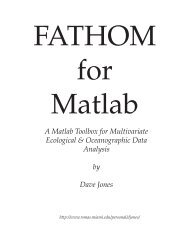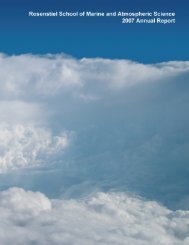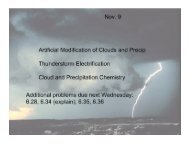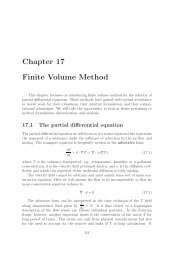A Brief History of the Joint Effect of Baroclinicity and Relief (JEBAR ...
A Brief History of the Joint Effect of Baroclinicity and Relief (JEBAR ...
A Brief History of the Joint Effect of Baroclinicity and Relief (JEBAR ...
Create successful ePaper yourself
Turn your PDF publications into a flip-book with our unique Google optimized e-Paper software.
A <strong>Brief</strong> <strong>History</strong> <strong>of</strong> <strong>the</strong> <strong>Joint</strong> <strong>Effect</strong> <strong>of</strong><br />
<strong>Baroclinicity</strong> <strong>and</strong> <strong>Relief</strong> (<strong>JEBAR</strong>) <strong>and</strong> its<br />
Application to Gulf Stream Separation<br />
MPO 611<br />
Geophysical Fluid<br />
Dynamics II<br />
Spring 2008<br />
Benjamin Shaw
A <strong>Brief</strong> <strong>History</strong><br />
●<br />
Sverdrup ocean circulation<br />
– Considers only wind stress, ignores bottom<br />
topographic effects<br />
●<br />
Sarkisyan & Ivanov (1971), <strong>the</strong> fa<strong>the</strong>rs <strong>of</strong><br />
<strong>JEBAR</strong><br />
– Pointed out that you can't ignore bottom baroclinic<br />
or bottom topographic effects<br />
– These have tremendous impact on transport in<br />
oceanic gyres
What is <strong>JEBAR</strong>?<br />
●<br />
The <strong>Joint</strong> <strong>Effect</strong> <strong>of</strong> <strong>Baroclinicity</strong> And <strong>Relief</strong><br />
– It is now well established that <strong>the</strong> combination <strong>of</strong><br />
baroclinicity <strong>and</strong> sloping bottom topography can<br />
give rise to a driving force for <strong>the</strong> depth-averaged<br />
flow (Mertz et. al., 1992)<br />
●<br />
Generally derived through some combination <strong>of</strong> depth<br />
averaging <strong>and</strong> cross differentiating simplified<br />
equations <strong>of</strong> motion
What is <strong>JEBAR</strong>?<br />
●<br />
There are several interpretations <strong>of</strong> <strong>JEBAR</strong>. It<br />
has been described by each <strong>of</strong> <strong>the</strong> following:<br />
– Geostrophic component <strong>of</strong> <strong>the</strong> correction to <strong>the</strong><br />
topographic stretching term to account for <strong>the</strong> fact<br />
that <strong>the</strong> bottom velocity, not <strong>the</strong> depth-averaged<br />
velocity, yields topographic vortex-tube stretching<br />
(Mertz, et. al. 1992)<br />
– Relates to bottom torque (curl <strong>of</strong> horizontal force by<br />
<strong>the</strong> bottom on <strong>the</strong> fluid) (Mertz, et. al. 1992)<br />
– Difference between bottom pressure torque <strong>and</strong> <strong>the</strong><br />
corresponding torque associated with <strong>the</strong> depth<br />
averaged pressure (Myers, et. al. 1996)
Derivation <strong>of</strong> <strong>the</strong> <strong>JEBAR</strong> term<br />
●<br />
<strong>JEBAR</strong> effect obtained when a<br />
vorticity equation is formed from<br />
<strong>the</strong> depth-averaged momentum<br />
equations (Huthnance 1984)<br />
●<br />
The result is Jacobian <strong>of</strong><br />
potential energy anomaly <strong>and</strong><br />
depth
●<br />
There are several interpretations <strong>of</strong> <strong>the</strong> <strong>JEBAR</strong><br />
term,depending on <strong>the</strong> choice <strong>of</strong> derivation. This version<br />
relates (in order):<br />
1. Rate <strong>of</strong> change <strong>of</strong> vorticity <strong>of</strong> <strong>the</strong> depth averaged flow<br />
2. Transport across contours <strong>of</strong> constant planetary vorticity<br />
3. Topographic vortex stretching<br />
4. Surface forcing/bottom dampening<br />
5. <strong>JEBAR</strong> effect<br />
(Mertz, et. al. 1992)
<strong>JEBAR</strong> Skeptics<br />
●<br />
●<br />
Some disagreement exists regarding<br />
<strong>the</strong> utility <strong>of</strong> <strong>the</strong> <strong>JEBAR</strong> effect<br />
Cane et. al. 1998 argues that:<br />
1) <strong>JEBAR</strong> term cannot be calculated consistently,<br />
leading to imperfect cancellation <strong>and</strong> spurious<br />
transport values<br />
2) Calculated velocity field is very noisy with large<br />
relative errors<br />
3) <strong>JEBAR</strong> overestimates <strong>the</strong> true influence <strong>of</strong><br />
topography on oceanic transports, especially since<br />
majority <strong>of</strong> transport is confined to upper layers
Application <strong>of</strong> <strong>JEBAR</strong><br />
●<br />
Reasons for separation <strong>of</strong> Gulf Stream from North<br />
American coast are unclear<br />
– Occurs at zero wind stress curl?<br />
– Bottom topography?<br />
– DWBC effects?<br />
– Cyclonic recirculation?<br />
●<br />
●<br />
GCMs predict separation<br />
~3000 km far<strong>the</strong>r north<br />
Myers, et. al. (1996) able<br />
to accurately predict<br />
separation point using FE<br />
model including <strong>JEBAR</strong>
Myers et. al. (1996)
Separation <strong>of</strong> <strong>the</strong> Gulf Stream<br />
●<br />
Dependent on <strong>JEBAR</strong> effect in 3 key areas<br />
– Offshore <strong>of</strong> separation<br />
– North Atlantic Bight<br />
– Central Irminger Sea<br />
●<br />
●<br />
Underestimating <strong>JEBAR</strong><br />
results in overshooting<br />
<strong>the</strong> actual separation<br />
point<br />
Which comes first?<br />
Separation or <strong>JEBAR</strong>?<br />
– Observed density field already has signature <strong>of</strong><br />
<strong>the</strong> separated Gulf Stream in it Myers et. al. (1996)
Conclusions<br />
●<br />
<strong>JEBAR</strong> effect:<br />
...shows <strong>the</strong> importance <strong>of</strong> baroclinic<br />
effects near <strong>the</strong> ocean bottom<br />
...is an important factor in oceanic<br />
gyre transport<br />
...provides solution to issue <strong>of</strong> Gulf<br />
Stream separation from North<br />
American coast<br />
...may be difficult to accurately<br />
measure
References<br />
Cane, M.A., V.M. Kamenkovich, A. Krupitsky, 1998: On <strong>the</strong> Utility <strong>and</strong> Disutility<br />
<strong>of</strong> <strong>JEBAR</strong>. Journal <strong>of</strong> Physical Oceanography – Notes & Correspondence,<br />
28, 519-526.<br />
Greatbatch, R.J., A.F. Fanning, A.D. Goulding, S. Levitus, 1991: A Diagnosis <strong>of</strong><br />
Interpentadal Circulation Changes in <strong>the</strong> North Atlantic. Journal <strong>of</strong><br />
Geophysical Research, 96, 22,009-22,023.<br />
Huthnance, J.M., 1984: Slope Currents <strong>and</strong> “<strong>JEBAR</strong>”. Journal <strong>of</strong> Physical<br />
Oceanography, 14, 795-810.<br />
Mellor, G., C. Mechoso, E. Keto, 1982: A diagnostic calculation <strong>of</strong> <strong>the</strong> Atlantic<br />
Ocean. Deep Sea Research, 29, 1171-1192.<br />
Mellor, G., 1999: Comments on “On <strong>the</strong> Utility <strong>and</strong> Disutility <strong>of</strong> <strong>JEBAR</strong>”. Journal<br />
<strong>of</strong> Physical Oceanography – Notes & Correspondence, 29, 2117-2118.<br />
Mertz, G., D.G. Wright, 1992: Interpretations <strong>of</strong> <strong>the</strong> <strong>JEBAR</strong> Term. Journal <strong>of</strong><br />
Physical Oceanography – Notes & Correspondence, 22, 301-305.<br />
Myers, P.G., A.F. Fanning, A.J. Weaver, 1996: <strong>JEBAR</strong>, Bottom Pressure<br />
Torque, <strong>and</strong> Gulf Stream Separation. Journal <strong>of</strong> Physical Oceanography, 26,<br />
671-683.


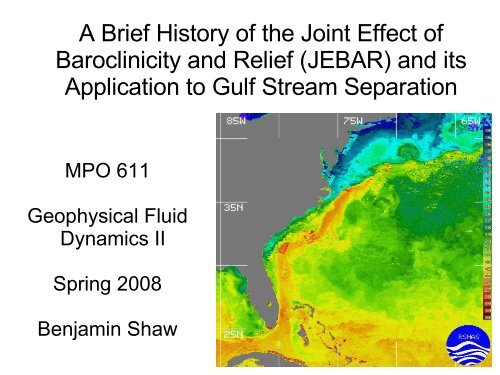

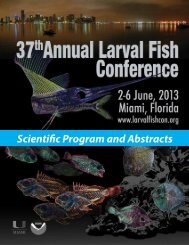
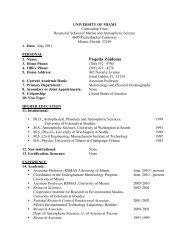
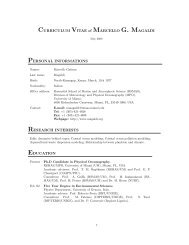
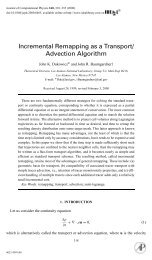
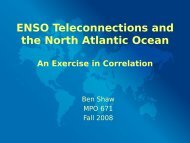
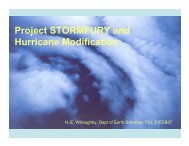
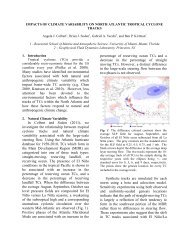

![Wavelength [μm] ZENITH ATMOSPHERIC TRANSMITTANCE](https://img.yumpu.com/26864082/1/190x143/wavelength-i-1-4-m-zenith-atmospheric-transmittance.jpg?quality=85)
